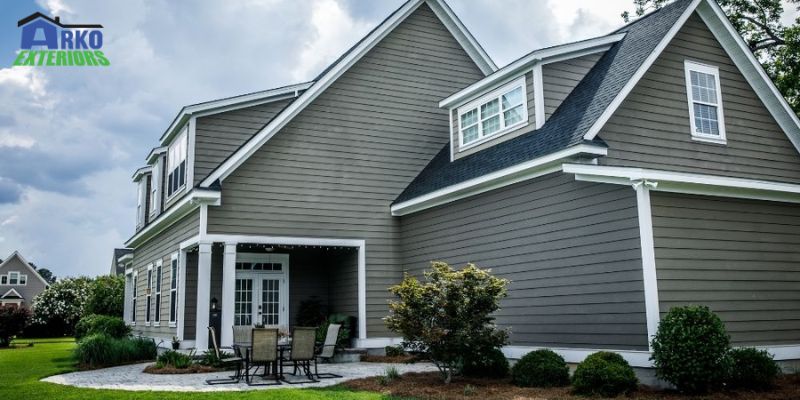When it comes to siding installation, one of the decisions you’ll need to make is whether to go with a vertical or horizontal orientation. Both options offer distinct visual aesthetics and have their advantages and considerations.
Which option is right for you? Think of these things…
#1 Visual Appeal

One of the first factors to consider is the visual appeal of your home. Horizontal siding installation is the most common choice, providing a traditional and timeless look. It follows the natural lines of your home and can create a sense of stability and balance. On the other hand, vertical siding installation offers a unique and modern aesthetic. It can make a bold design statement and add a sense of height and elegance to your home’s exterior. Ultimately, the choice between vertical and horizontal siding will depend on your personal preference and the architectural style of your home.
#2 Weather Resistance

Weather resistance is a critical aspect to consider when choosing siding installation. Horizontal siding, with its overlapping design, provides excellent protection against rainwater and moisture infiltration. The horizontal orientation helps shed water away from the exterior walls, reducing the risk of water damage. Vertical siding, on the other hand, may require additional measures, such as proper sealing and water-resistant barriers, to ensure effective water management. The climate and weather patterns in your area should be taken into account when deciding between vertical and horizontal siding installation.
#3 Maintenance & Durability
Maintenance and durability are important considerations for any siding choice. Horizontal siding is generally easier to maintain, as it is easier to clean and replace individual sections if necessary. However, horizontal siding may be more prone to collecting dirt, debris and moisture in its horizontal grooves. Vertical siding, although requiring more attention during installation and potential caulking of vertical seams, can be easier to clean and maintain due to its smooth, vertical surface. Both orientations can provide durability when installed correctly and maintained regularly.
#4 Architectural Considerations
The architectural design of your home can play a significant role in the decision-making process. Some architectural styles lend themselves better to horizontal siding, such as traditional, colonial or ranch-style homes. The horizontal lines complement these designs and maintain their classic appeal. Vertical siding, on the other hand, can enhance the visual interest of contemporary or modern architectural styles. It adds a vertical emphasis that complements clean lines and unique architectural features. Consider the overall architectural style of your home and consult with professionals to ensure the siding installation aligns with the desired aesthetic.
#5 Cost Considerations
Cost is another factor to evaluate when choosing between vertical and horizontal siding installation. Horizontal siding is typically more cost-effective due to its widespread availability and easier installation process. Vertical siding may require additional materials, such as trim pieces, to complete the installation properly. The overall cost will depend on factors such as the siding material, the size of your home and the complexity of the installation. It is recommended to obtain quotes from reputable contractors to assess the cost implications of each option.
#6 Expansion & Contraction
Expansion and contraction of siding materials due to temperature fluctuations should be taken into account. Horizontal siding, with its longer lengths, can accommodate more significant expansion and contraction without visible effects. Vertical siding, on the other hand, may require additional measures to address potential issues related to expansion and contraction. Proper installation techniques, such as allowing for proper gaps and using appropriate fasteners, can help mitigate any concerns.
#7 Visual Effects
The orientation of siding can have an impact on the perceived dimensions of your home. Horizontal siding can make a home appear wider, emphasizing its width. This effect can be beneficial for homes with narrow facades, as it visually widens the appearance. Vertical siding, on the other hand, can create an illusion of height, making a home appear taller. This effect can be advantageous for homes with low rooflines or in situations where you want to draw attention upward.
#8 Regional Preferences
Siding preferences can vary based on regional architectural styles and traditions. Certain regions or neighborhoods may have a prevailing preference for either vertical or horizontal siding. Consider the aesthetics of the surrounding homes in your area to ensure your choice aligns with the local style. While it’s essential to make your home unique, maintaining a cohesive look with the neighborhood can enhance curb appeal and potential resale value.
#9 Design Variations
Both vertical and horizontal siding offer design variations that can further enhance the aesthetic appeal of your home. Horizontal siding can be installed with different profiles, such as traditional lap siding, shingles or panels. Vertical siding also provides options such as board and batten, panel siding or vertical shiplap. Exploring the design variations available for each orientation can help you find the style that best suits your personal taste and complements your home’s architecture.
#10 Environmental Considerations
Environmental factors may influence your siding choice. For instance, in areas with high winds or frequent storms, vertical siding may provide better resistance to wind-driven rain. Additionally, vertical siding can minimize the accumulation of leaves, debris and pests compared to horizontal siding. Consider the specific environmental conditions of your location to make an informed decision.
Summary:
Choosing between vertical and horizontal siding installation involves considering visual appeal, weather resistance, maintenance and durability, architectural considerations and cost. Ultimately, the decision should align with your personal preferences, the architectural style of your home and the specific requirements of your location and climate. Consulting with siding professionals can provide valuable insights and guidance in making the right choice. By carefully evaluating these factors, you can select the siding installation that best suits your home and enhances its overall aesthetic and functionality.

